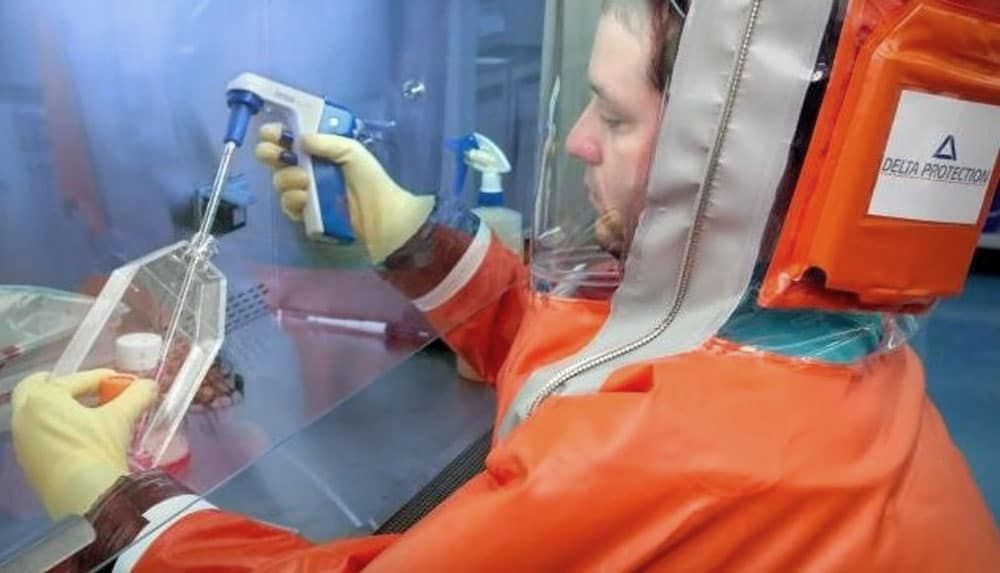Synthetic biology: A call for a new culture of responsibility
By Ali Nouri, Shahram Seyedin-Noor | December 7, 2018
 Research on smallpox continues today. Photo credit: Centers for Disease Control
Research on smallpox continues today. Photo credit: Centers for Disease Control
In 1980, the World Health Organization declared the official eradication of smallpox.
This was one of modern medicine’s crowning achievements—the elimination of a virus estimated to have killed more than 300 million people in the 20th century. That’s three times the combined death tolls of all the wars fought during the same period, including WWI and WWII.
Today, scientists hold the tools to resurrect smallpox from scratch. David Baltimore, winner of the 1975 Nobel Prize in medicine, put it simply: “The smallpox sequence is published, so you could recover it by synthesis if you had the lab facilities to do that.”
In fact, they’ve done just that with several other viruses. Last year, Canadian researchers reconstituted the “extinct” horsepox virus, a cousin of smallpox, for $100,000, using mail-order DNA. That experiment follows others like it, including the assembly of the much smaller poliovirus in 2002 and the resurrection in 2005 of the H1N1 pandemic virus, also known as the “Spanish influenza”—a virus that wiped out 50 million people a century ago. Underlying these scientific milestones and many other contributions to healthcare is a field called synthetic biology—and it is gaining speed.
Synthetic biology, sometimes called synbio, is an interdisciplinary field that combines the principles of engineering and biology to produce products for agriculture, healthcare, foods, materials science, and more. It enables the manipulation of biological systems—from molecules to cells to organisms—in a systematic way to achieve particular functions. As the Engineering Biology Research Consortium (EBRC) explains on its website: “Just as engineers now design integrated circuits based on the known physical properties of materials and then fabricate functioning circuits and entire processors (with relatively high reliability), synthetic biologists will soon design and build engineered biological systems.”
Importantly, the EBRC adds this: “Unlike many other areas of engineering, biology is incredibly non-linear and less predictable, and there is less knowledge of the parts and how they interact.”
And therein lies the rub.
Tremendous potential, real risks. During the first week of October, at the SynBioBeta 2018 Conference in San Francisco, scientists, engineers, entrepreneurs, policymakers, and venture capitalists from around the world showcased the latest advances in the field. The power of biotechnology as a force for good was readily apparent, as attendees discussed cutting-edge innovations like the storage of digital information (0s and 1s) in DNA molecules, and rewiring the genetic circuitry of bacteria to make biosensors that can detect environmental pollutants.
But synthetic biology also presents risks that need to be managed.
One such risk stems from the potential for dual-use applications of biotechnology—such as the possibility that this technology could be diverted to construct toxins and pathogens for use as biological weapons. As the building blocks of synthetic biology become more decentralized, or “democratized,” the risk goes up that these tools will be misused by individuals with sinister intentions.
Consider DNA synthesis technology. The ability to construct long DNA molecules efficiently and affordably from chemical precursors has been a significant benefit to startups in the world of synthetic biology and to scientists in universities, who can now outsource this tedious task to centralized facilities. But this also opens the door to the possibility that an individual with evil intent will order genes belonging to toxins and pathogens and introduce those genes into cells or cell-free extracts where they can be transcribed and subsequently translated into toxins—or even disease-causing viruses.
DNA synthesis companies have responded to this risk by undertaking prudent self-regulation under the banner of the International Gene Synthesis Consortium (IGSC). In 2009, IGSC members began to screen the identities of both their customers and any orders of double stranded DNA molecules above 200 nucleotides in length (nucleotides are the fundamental chemical units that make up strands of DNA). The goal was to ensure that DNA sequences belonging to a list of toxins and pathogens are only provided to researchers specifically authorized to work with those agents.
This framework, which was implemented almost 10 years ago, is still in effect today. It is not, however, without its shortcomings. There are technical challenges to screening the shorter oligonucleotides (short series of nucleotides) which can be used to construct bigger DNA molecules. Moreover, IGSC’s membership covers only 80 percent of the gene synthesis market, leaving a hole that a bad actor could conceivably exploit.
And this framework has been largely static—while technology has not. As synbio accelerates, the risks increase. For instance, companies are hard at work building desktop gene synthesizers that could be sold to laboratories, or even individuals. That is going to require a different risk-mitigation framework than the one currently in place at centralized DNA factories. Other companies are working to create new platforms that could generate molecules and modified organisms to treat disease. These same technologies could be used to make novel toxins and pathogenic organisms. Add to this the trend towards robotics automation, new advancements in software and computer assisted biological design (Bio-CAD), and artificial intelligence, and it becomes clear that even a novice without formal scientific training could eventually use these tools, for good or evil.
Where do we go from here? Clearly, it is in the interest of the synthetic biology community to ensure that its tools are neither used, nor attempted to be used, for nefarious purposes. In an extreme scenario, the misuse of biotechnology could lead to severe risks for humanity. (And even a more minor mishap could hamper innovation and growth in a budding industry by provoking reactive government regulations or scaring away investors.)
The industry as a whole has an opportunity to build on the initial self-regulation model that has been employed by several pioneering gene synthesis companies. Scientists and engineers who are developing new technologies are well-positioned to think through tailored technical and institutional safeguards to prevent misuse. They should build bridges to the policy community to assess risks, develop proposed guidelines, and implement them in such a way as to foster, not impede, further innovation.
For their part, commercial enterprises—including startups and the private venture capitalists who fund them—could adopt a culture of proactive vigilance that prioritizes the identification and mitigation of risks. The “Move Fast and Break Things” mantra popularized by Mark Zuckerberg has helped spur innovation, but it has also introduced new risks. As seen in the recent Russian interference in US elections, even seemingly harmless technologies like social media, without effective safeguards, can have destructive dual-use applications. In the case of synthetic biology, the potential for misuse and need for risk mitigation is even more obvious. (Even Zuckerberg’s Facebook has changed its slogan.)
Gene synthesis companies have already demonstrated that academic, commercial, and policy communities can work together to safeguard against risks within a dynamic framework that champions transparency, open channels, interdisciplinary collaboration, and industry standards that must be universally adopted to be truly effective. Synthetic biology is not unique in its dual-use nature—artificial intelligence and other fledgling fields also carry tremendous benefits as well as risks.
By building on—and going beyond—the existing risk mitigation framework for DNA synthesis, the synthetic biology community can set a powerful example for other sectors to follow.
Together, we make the world safer.
The Bulletin elevates expert voices above the noise. But as an independent nonprofit organization, our operations depend on the support of readers like you. Help us continue to deliver quality journalism that holds leaders accountable. Your support of our work at any level is important. In return, we promise our coverage will be understandable, influential, vigilant, solution-oriented, and fair-minded. Together we can make a difference.
Keywords: biotechnology, biowarfare, disruptive technology, synthetic biology
Topics: Opinion, Synthetic biology















